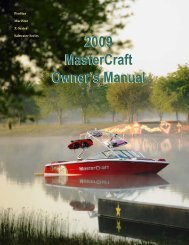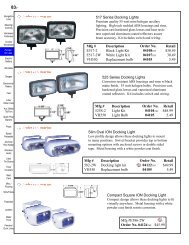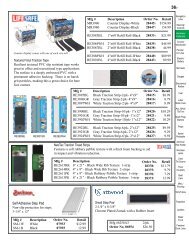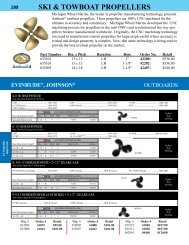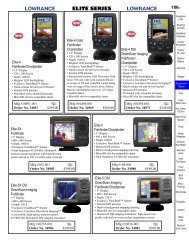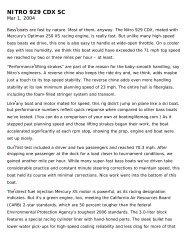Proudly Presented By HMY Yacht Sales, Inc.
Proudly Presented By HMY Yacht Sales, Inc.
Proudly Presented By HMY Yacht Sales, Inc.
You also want an ePaper? Increase the reach of your titles
YUMPU automatically turns print PDFs into web optimized ePapers that Google loves.
TOURNAMENT RULES<br />
as formulated by the IGFA, continued<br />
I. OTHER EQUIPMENT<br />
1. Fighting chairs may not have any mechanically propelled<br />
devices which aid the angler in fighting a fish.<br />
2. Gimbals must be free swinging, which includes gimbals<br />
that swing in a vertical plane only. Any gimbal that allows<br />
the angler to reduce strain or rest while fighting the fish<br />
is prohibited.<br />
3. Gaffs and nets used to boat or land a fish must not<br />
exceed 8 feet (2.49 meters) in overall length. In using a<br />
flying or detachable gaff, the rope may not exceed 30 feet<br />
(9.14 meters). The gaff rope must be measured from the<br />
point where it is secured to the detachable head to the<br />
other end. Only the effective length will be considered. If<br />
a fixed head gaff is used, the same limitations shall apply<br />
and the gaff rope shall be measured from the same<br />
location on the gaff hook. Only a single hook is permitted<br />
on any gaff. Harpoon or lance attachments are prohibited.<br />
Tail ropes are limited to 30 feet (9.14 meters). (When<br />
fishing from a bridge, pier, or other high platform or<br />
structure, this length limitation does not apply.)<br />
4. Floats are prohibited with the exception of any small<br />
flotation device attached to the line or leader for the sole<br />
purposed of regulating the depth of the bait. The flotation<br />
device must not in any way hamper the fighting ability of<br />
the fish.<br />
5. Entangling devices, either with or without hook, are<br />
prohibited and may not be used for any purpose<br />
including: baiting, hooking, fighting, or landing the fish.<br />
6. Outriggers, downriggers, and kites are permitted to be<br />
used provided that the actual fishing line is attached to<br />
the snap or other release device, either directly or with<br />
some other material. The leader or double line may not<br />
be connected to the release mechanism either directly or<br />
with use of a connecting device.<br />
7. Umbrella or spreader rigs, daisy chains and similar<br />
devices may only be used if they do not unfairly hamper<br />
or inhibit the normal swimming or fighting ability of the<br />
fish, thereby giving the angler or crew an unfair<br />
advantage in fighting, landing, or boating the fish.<br />
8. A safety line may be attached to the rod provided that it<br />
does not in any way assist the angler in fighting the fish.<br />
ANGLING REGULATIONS<br />
1. From the time that a fish strikes or takes bait or lure, the<br />
angler must hook, fight, and land or boat the fish without<br />
the aid of any other person, except as provided in these<br />
regulations.<br />
2. If a rod holder is used and fish strikes or takes the bait<br />
or lure, the angler must remove the rod from the holder as<br />
quickly as possible. The intent of this rule is that the<br />
angler shall strike and hook the fish with the rod in hand.<br />
3. In the event of a multiple strike on separate lines being<br />
fished by a single angle, only the first fish fought by the<br />
angler will be considered for a world record.<br />
4. If a double line is used, the intent of the regulations is<br />
that the fish will be fought on a single line most of the<br />
time that it takes to land the fish.<br />
5. A harness may be attached to the reel or the rod, but not<br />
to the fighting chair. The harness may be replaced or<br />
adjusted by a person other than the angler.<br />
6. Use of a rod belt or waist gimbal is permitted.<br />
7. When angling from a boat, once the leader is brought<br />
within the grasp of the mate, or the end of the leader is<br />
wound to the rod tip, more than one person is permitted<br />
to hold the leader.<br />
8. One or more gaffers may be used in addition to persons<br />
holding the leader. The gaff handle must be in hand when<br />
the fish is gaffed.<br />
9. The angling and equipment regulations shall apply until<br />
the fish is weighed.<br />
THE FOLLOWING ACTS WILL DISQUALIFY A CATCH:<br />
1. Failure to comply with the equipment or angling<br />
regulations.<br />
2. The act of persons other than the angler in touching any<br />
part of the rod, reel, or line (including the double line)<br />
either bodily or with any device, from the time a fish<br />
strikes or takes the bait or lure, until the fish is either<br />
landed or released, or in giving any aid other than that<br />
allowed in the rules and regulations. If an obstacle to the<br />
passage of the line through the rod guides has to be<br />
removed from the line, then the obstacle (whether chum,<br />
floatline, rubber band, or other material) shall be held and<br />
cut free. Under no circumstances should the line be held<br />
or touched by anyone other than the angler during this<br />
process.<br />
3. Resting the rod in a rod holder, on the gunwale of the<br />
boat, or any other object while playing the fish.<br />
4. Handlining or using a handline or rope attached in any<br />
manner to the angler’s line or leader for the purpose of<br />
holding or lifting the fish.<br />
5. Shooting, harpooning, or lancing any fish (including<br />
sharks and halibuts) at any stage of the catch.<br />
6. Chumming with or using as bait the flesh, blood, skin, or<br />
any part of mammals other than hair or pork rind used in<br />
lures designed for trolling or casting.<br />
7. Using a boat or device to beach or drive a fish into<br />
shallow water in order to deprive the fish of its normal<br />
ability to swim.<br />
8. Changing the rod or reel while the fish is being played.<br />
9. Splicing, removing, or adding to the line while the fish is<br />
being played.<br />
10.Intentionally foul-hooking a fish.<br />
11. Catching a fish in a manner that the double line never<br />
leaves the rod tip.<br />
12.Using a size or kind of bait that is illegal to possess.<br />
13.Attaching the angler’s line or leader to part of the boat or<br />
other object for the purpose of holding or lifting the fish.<br />
14.If a fish escapes before gaffing or netting and is<br />
recaptured by any method other than as outlined in the<br />
angling rules.<br />
THE FOLLOWING SITUATIONS WILL DISQUALIFY A CATCH:<br />
1. When a rod breaks (while the fish is being played) in a<br />
manner that reduces the length of the tip below minimum<br />
dimensions or severly impairs its angling characteristics.<br />
2. Mutilation to the fish, prior to landing or boating the catch,<br />
caused by sharks, other fish, mammals, or propellers that<br />
remove or penetrate the flesh. (Injuries caused by the leader<br />
or line, scratches, old healed scars or regeneration<br />
deformities are not considered to be disqualifying injuries).<br />
3. When a fish is hooked or entangled on more than one line.





